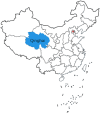The Effect of Lamb Vaccination Against Echinococcosis on the Scale of Livestock Farming in Northwestern China
- PMID: 40028713
- PMCID: PMC11875069
- DOI: 10.1002/vms3.70273
The Effect of Lamb Vaccination Against Echinococcosis on the Scale of Livestock Farming in Northwestern China
Abstract
Echinococcosis (also known as 'hydatidosis' or 'hydatid disease') is a severe zoonotic disease that poses threats to human and animal health and significantly impacts livestock production, which may lead to declines in both the quantity and quality of animal products and result in economic losses. Lamb vaccination against echinococcosis is considered an effective method for controlling the transmission of echinococcosis in the intermediate host-sheep, thereby disrupting the disease's transmission chain, and thus a crucial strategy for preventing and controlling echinococcosis. Based on field survey data on 581 households collected from 11 counties of China's Qinghai Province, this study evaluated the impact of lamb vaccination against echinococcosis on livestock farming scale using a staggered difference-in-differences method. The results show that on average, households that received lamb vaccination from their county as part of the 'Action Plan for Echinococcosis Prevention and Control in Qinghai Province (2016-2020)' had a livestock farming scale of 52.09 heads (or 36%) higher than those that did not receive lamb vaccination. This effect likely works through reductions in cattle and sheep mortality and culling numbers. A simple accounting analysis suggested that the increase in livestock farming scale can translate into a profit of 26,500 yuan (≈3938 US dollars at 2022 prices), although this impact has a short-term lag and is limited in duration. While these findings may not apply to all livestock households in China, they suggest that developing area-specific lamb vaccination programs, increasing lamb vaccination rates, and ensuring timely vaccinations are crucial for enhancing livestock farming scale in echinococcosis endemic areas.
Keywords: China; echinococcosis; farming scale; households; lamb vaccination; staggered difference‐in‐differences method.
© 2025 The Author(s). Veterinary Medicine and Science published by John Wiley & Sons Ltd.
Conflict of interest statement
The authors declare no conflicts of interest.
Figures


References
-
- Baker, A. C. , Larcker D. F., and Wang C. C. Y.. 2022. “How Much Should We Trust Staggered Difference‐in‐differences Estimates?” Journal of Financial Economics 144, no. 2: 370–395.
-
- Bava, L. , Sandrucci A., Zucali M., Guerci M., and Tamburini A.. 2014. “How Can Farming Intensification Affect the Environmental Impact of Milk Production?” Journal of Dairy Science 97, no. 7: 4579–4593. - PubMed
Publication types
MeSH terms
Grants and funding
- 2020-ZJ-Y01/Key Laboratory Project of Science and Technology Department of Qinghai Province
- 2020-SF-133/Application of Key Technologies for Intelligent Control of Hydatid Source
- 202207211110013/Economic Analysis and Evaluation of Hydatid Disease Prevention and Control in Qinghai Province
- 22&ZD113/National Social Science Fund of China
LinkOut - more resources
Full Text Sources
Medical

